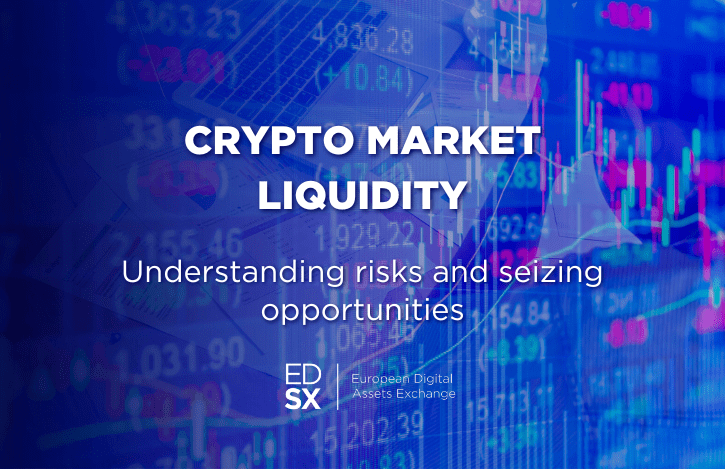If you’re new to investing, one of the most important concepts to understand is liquidity. Liquidity refers to how easily an asset can be converted into cash. Traders can easily sell assets with high liquidity, like cash itself, without affecting the asset’s value. Digital asset markets have experienced periods of volatility where liquidity has dried up, making it difficult to sell quickly or could require selling at a discount. During times of low crypto market liquidity, even normally highly-liquid digital assets may become difficult to offload without a price impact. Understanding an asset’s liquidity is key to managing risk, especially in innovative markets like cryptocurrencies that can experience rapid changes in trading activity.
As a new investor, liquidity is especially important for managing risk and planning your investment strategy. It determines your ability to freely buy and sell assets when needed. While more traditional markets for stocks, bonds and cash have stable levels of liquidity day to day, newer digital asset classes still have developing infrastructure and user adoption curves. This means that at times of high volatility, converting certain digital assets to cash may take longer and require accepting lower sale prices than usual. Let’s explore why having an awareness of liquidity conditions matters so much for navigating opportunities and risks within the digital asset space.
What is Liquidity and Why Does it Matter?
Liquid assets are those that can be bought and sold easily in large volumes without substantially changing the asset’s market price. Traders can instantly convert cash and bank deposits to other forms of payment, making them extremely liquid.
Crypto market liquidity protects investors in several ways:
- It allows for smooth transactions and buying/selling without major delays. This provides flexibility to enter and exit positions.
- Assets with higher liquidity have lower volatility since demand and supply can be easily met. Prices aren’t artificially changed by temporary factors.
- In times of economic uncertainty, liquid assets can be quickly converted to cash for protection or opportunity without taking losses.
- For new investors, liquidity provides the ability to change investment strategies easily as goals, risk tolerance, and market conditions evolve over time. It’s essential for smoothly executing a planned exit from positions when needed.
Liquidity in Crypto Markets
While digital asset markets have grown, liquidity remains riskier than traditional assets like stocks. Some digital asset exchanges operate globally while other focus regionally, compared to well-estbalished financial markets. Transaction fees and delays also impact liquidity.
Factors influencing the liquidity of different digital assets include exchange volumes, adoption rates, regulations in various jurisdictions, and awareness/education levels. Higher trading volumes require competitive markets with low costs and fast execution of orders and withdrawals.
Liquidity challenges in digital assets come with price volatility risks. Supply and demand shifts could cause short-term price fluctuations before markets stabilize. For new investors, carefully manage risk exposures, especially during periods of lower liquidity and higher volatility.
Considering Liquidity for Your Strategy
Given the volatile nature of crypto markets, liquidity is a key concern for digital asset investments. Maintaining exposure to stable, liquid assets can help weather volatility. Closely, monitoring supply and demand factors that impact liquidity is important for risk management. Diversifying across exchanges provides flexibility if liquidity arise on any one platform. Limit orders allow for pre-planned transactions while avoiding low liquidity risks.
Overall, liquidity is a consideration for investors. The evolving digital assets market presents new risks compared to traditional assets. While infrastructure and market development may improve crypto liquidity over time, volatility means liquidity will likely remain a bigger factor than other markets. Newcomers should prioritize liquid large-cap coins across exchanges for flexibility to manage risk. Initially focus assets in stable liquid positions using limit orders to weather evolving conditions with minimal disruption.
With liquidity serving as the key to risk management, those just starting their digital asset investment journey would be wise to emphasize it as a core consideration in building their portfolio. A focus on liquidity helps ensure newcomers can participate in this nascent’s market’s opportunities while avoiding undue exposure during periods of turbulence.

Based in Zug, the platform is fully compliant with all Swiss laws related to financial intermediaries, banking, anti-money laundering, and organized trading facilities. Among its core values, there are innovative solutions through blockchain technology, which ensures security and liquidity.
EDSX is the first platform in Europe with primary and secondary markets for both institutional and retails. EDSX is a pioneering platform that employs the world’s leading technology to globally list security tokens in both primary and secondary markets, listing digital securities of real financial instruments to the public with a decentralized peer-to-peer exchange. Our goal is to fully engage every aspect of the financial revolution.
Do you have a question for us?
Send your query here:
[email protected]

